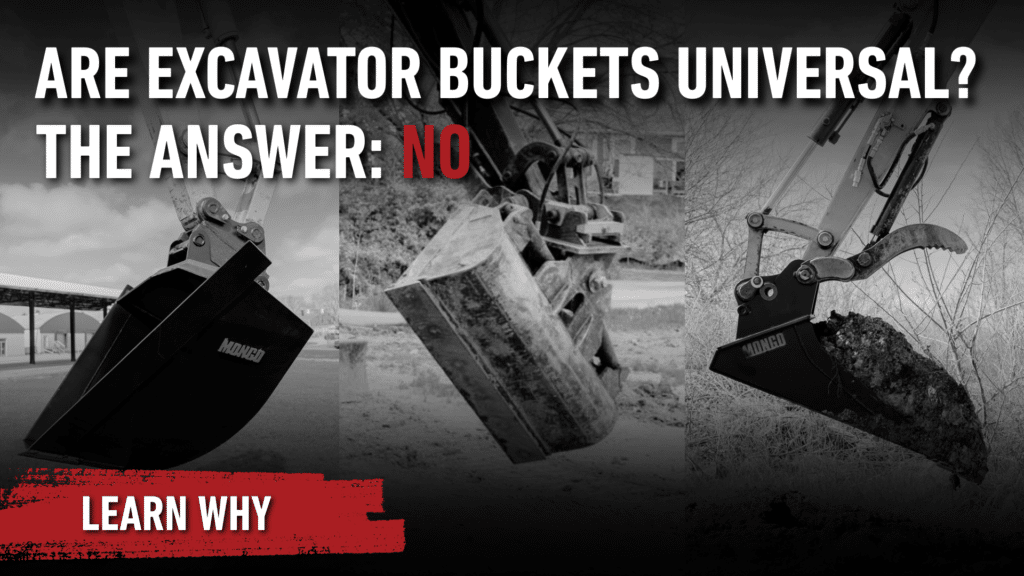
Are Excavator Buckets Universal? What You Need to Know
Choosing the right excavator bucket is essential for optimizing performance and efficiency on the job site. But many operators wonder: Are excavator buckets universal? The answer: no—excavator buckets are not always universal. In this blog, we’ll explore why compatibility matters, the role of couplers, and how to select the perfect bucket for your machine.
Excavator Bucket Compatibility
While excavator buckets are not universally compatible, certain buckets can fit multiple machines.
However, compatibility becomes more complex with larger machines (e.g., 12-ton or 20-ton excavators). These often use hydraulic quick couplers with traveling latches that make bucket interchangeability more feasible. The hydraulic hitch compensates for differences in pin centers, allowing some level of universality.
Using an incompatible bucket can lead to:
- Reduced efficiency
- Potential damage to your machine
- Safety hazards for operators and bystanders
Understanding what makes a bucket compatible ensures you get the job done right.
Mechanical vs. Hydraulic Couplers: Choosing the Right Connection
The coupler connects the excavator arm to the bucket and plays a key role in compatibility. Here’s an overview of the two main types:
Mechanical Couplers
- Pros: Cost-effective and simple.
- Cons: Require manual pin removal and insertion, which can be time-consuming and labor-intensive.
- Best For: Jobs where bucket changes are infrequent.
Hydraulic Couplers
- Pros: Allow quick bucket changes directly from the cab, saving time.
- Cons: More expensive than mechanical couplers.
- Best For: Projects requiring frequent attachment changes.
Choosing the right coupler ensures your excavator is versatile and ready for any task.
Key Factors That Determine Bucket Compatibility
To determine which buckets fit your excavator, you need to know three key measurements:
- Pin Diameter
- Pin Centers (distance between pins)
- Dipper Gap (space between mounting plates)
These measurements are critical when purchasing buckets or attachments. Manufacturers will request this information to ensure a proper fit.
Other factors include:
- Machine Make and Model: Each brand has its own specifications.
- Excavator Size and Weight Capacity: Larger machines require heavier-duty buckets.
- Intended Use: The type of material and task will influence bucket selection.
Common Types of Excavator Buckets
Different tasks require different buckets. Here are some common types:
- General Purpose Buckets: Versatile for most digging tasks.
- Digging Buckets: Designed for breaking ground efficiently.
- Spade Buckets: Narrower for digging precise trenches, and the benefits are unmatched.
- V-Buckets: Ideal for shaping ditches or trenches and often preferred over regular or trenching buckets for drainage work.
- Grading Buckets: Wide and flat for leveling surfaces.
- Heavy-Duty Buckets: Built to handle tough materials like rock or debris.
- Tilt Buckets: Offers versatility by allowing the operator to tilt the bucket at various angles, making it useful for precise digging and shaping
How to Select the Right Bucket for Your Excavator
When selecting a bucket, consider these factors:
- Excavator Size and Capacity: Ensure the bucket size matches your machine’s weight class.
- Intended Use: Match the bucket type to your job requirements (e.g., digging vs. grading).
- Compatibility: Verify pin dimensions and coupler type with your manufacturer or dealer.
Tips for Bucket Selection and Use
- Avoid exceeding your excavator’s operating capacity; oversized buckets can strain the machine.
- Use the correct bucket size for efficiency—too small limits productivity, while too large risks safety issues.
- Consider additional features like side cutters or wear strips to enhance durability.
Maximizing Efficiency and Safety with the Right Bucket
Choosing the right excavator bucket isn’t just about convenience—it’s about safety, efficiency, and getting the job done right. By understanding compatibility factors like pin dimensions, coupler types, and intended use, you can make informed decisions that maximize your machine’s potential and your project’s success.
At Mongo Attachments, we understand the complexities of excavator bucket selection. Our team of experts is ready to help you navigate the process of finding the perfect bucket for your specific excavator and job requirements.
At Mongo Attachments, we take the guesswork out of bucket selection. Our experts are ready to help you:
- Identify the correct bucket size based on your excavator’s specifications
- Choose the best bucket type for your specific job needs
- Ensure seamless compatibility with your machine’s pin dimensions and coupler type
- Recommend additional features like side cutters or wear strips for extended durability
Don’t let the wrong bucket slow you down. Get the right attachment for the job and maximize your excavator’s potential.
Visit a dealer near you or contact out sales team today to find the perfect excavator bucket solution.
Read More from Mongo Attachments:
Choosing the right excavator bucket is essential for optimizing performance and efficiency on the job site. But many operators wonder: Are excavator buckets universal? The answer: no—excavator buckets are not always universal. In this blog, we’ll explore why compatibility matters, the role of couplers, and how to select the perfect bucket for your machine. Excavator… Read More »Are Excavator Buckets Universal? What You Need to Know
Mongo Attachments has introduced its new ProGrade Forestry Mulcher line, expanding its range of land-clearing solutions for excavators from 7,000 to 26,000 lbs. This innovative line builds upon the success of the Gen 2 Forestry Mulcher, setting a new standard in land-clearing technology. The ProGrade series represents a significant advancement in mulching capability, designed to… Read More »Transform Your Land-Clearing Operations with Mongo Attachments New ProGrade…
When it comes to excavation, choosing the right bucket attachment is crucial to achieving optimal efficiency and project success. While various bucket types serve distinct purposes, drainage ditch and trench construction for pipes and cables often presents a unique challenge. Traditional buckets may leave uneven sides, and dedicated trenching buckets might not be ideal for… Read More »V-Bucket vs Regular Bucket vs Trenching Bucket: Dig Smarter…



